Themed collection Spin State Switches in Molecular Materials Chemistry

Spin-state switches in molecular materials chemistry
Guest editors Shinya Hayami, Stephen M. Holmes and Malcolm A. Halcrow introduce this Journal of Materials Chemistry C themed issue on spin-state switches in molecular materials chemistry.

J. Mater. Chem. C, 2015,3, 7775-7778
https://doi.org/10.1039/C5TC90128F
A heterospin pressure sensor
The spin transition temperature of the Cu(II)-nitroxide complex was found to shift by approximately 100 K toward higher temperatures when the hydrostatic pressure increased to ∼0.04 GPa.
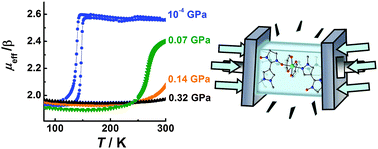
J. Mater. Chem. C, 2015,3, 7788-7791
https://doi.org/10.1039/C5TC01005E
Femtosecond spin-state photo-switching dynamics in an FeIII spin crossover solid accompanied by coherent structural vibrations
Femtosecond optical spectroscopy reveals coherent structural trapping accompanying spin-state photoswitching in a FeIII spin-crossover material.
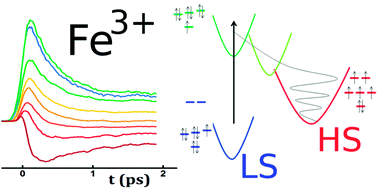
J. Mater. Chem. C, 2015,3, 7792-7801
https://doi.org/10.1039/C5TC00854A
Heating-rate dependence of spin-crossover hysteresis observed in an iron(II) complex having tris(2-pyridyl)methanol
Me4N[Fe(py3COH)(NCS)3](H2O) showed an abrupt spin-crossover with thermal hysteresis, and temperature-scan rate dependence was recorded upon heating.
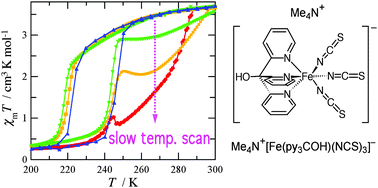
J. Mater. Chem. C, 2015,3, 7784-7787
https://doi.org/10.1039/C5TC00926J
Supramolecular control of reverse spin transitions in cobalt(II) terpyridine complexes with diblock copolypeptide amphiphiles
The composites composed of the cobalt terpyridine complex [CoII(MeO-terpy)2]2+ and the diblock copolypeptide amphiphiles (including glutamic acid and leucine) with rectangular morphology and reverse spin transition were prepared.
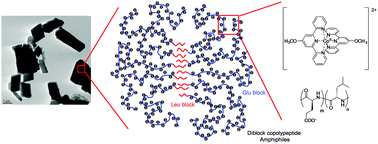
J. Mater. Chem. C, 2015,3, 7779-7783
https://doi.org/10.1039/C5TC00677E
Spin-crossover in a homoleptic cobalt(II) complex containing a redox-active NNO ligand
We report the structural and variable temperature magnetic properties of divalent cobalt complex containing the ligand 1-(2-pyridylazo)-2-phenanthrol (papl). This complex provides a rare example of spin-crossover in cobalt complexes with redox-active NNO donor ligands.
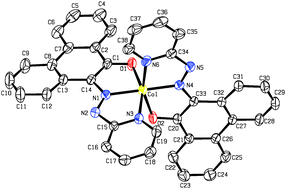
J. Mater. Chem. C, 2016,4, 455-459
https://doi.org/10.1039/C5TC03137K
A charge neutral iron(II) complex with an above room temperature spin crossover (SCO) and hysteresis loop
A luminescent charge neutral Fe(II) complex [Fe(L1)2] with above room temperature hysteretic spin crossover (SCO) is reported; a phase transition is associated with SCO as inferred from thermal and SAXS studies.
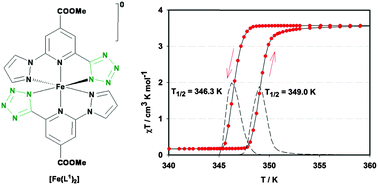
J. Mater. Chem. C, 2015,3, 11635-11644
https://doi.org/10.1039/C5TC02079D
Structural distortions of the spin-crossover material [Co(pyterpy)2](TCNQ)2 mediated by supramolecular interactions
Supramolecular interactions between the terminal pyridyl groups and TCNQ radicals induce structural distortions in [Co(pyterpy)2](TCNQ)2 spin-crossover materials.
2 mediated by supramolecular interactions](/en/Image/Get?imageInfo.ImageType=GA&imageInfo.ImageIdentifier.ManuscriptID=C5TC01851J&imageInfo.ImageIdentifier.Year=2015)
J. Mater. Chem. C, 2015,3, 9292-9298
https://doi.org/10.1039/C5TC01851J
Photo-induced magnetic properties of the [CuII(bapa)]2[MoIV(CN)8]·7H2O molecular ribbon
A novel 1-D photomagnetic L-CuII–[MoIV(CN)8]4− complex was obtained, in which the photomagnetic effect is fully reversible by heating above 253 K, and partially reversible by irradiation with red and infrared light.
![Graphical abstract: Photo-induced magnetic properties of the [CuII(bapa)]2[MoIV(CN)8]·7H2O molecular ribbon](/en/Image/Get?imageInfo.ImageType=GA&imageInfo.ImageIdentifier.ManuscriptID=C5TC01889G&imageInfo.ImageIdentifier.Year=2015)
J. Mater. Chem. C, 2015,3, 8712-8719
https://doi.org/10.1039/C5TC01889G
Spatially inhomogeneous, stepwise phase transitions in a thiazyl diradical: a structural mismatch induced by lattice transformation
Bis(1,2,3,5-dithiadiazolyl)-4,4′-biphenylene exhibits spatially inhomogeneous, stepwise phase transitions, which are caused by a “bond frustration”, as seen in frustrated gear trains.
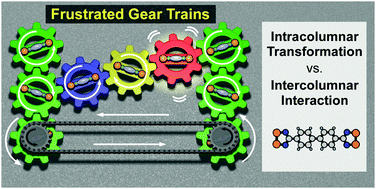
J. Mater. Chem. C, 2015,3, 7968-7977
https://doi.org/10.1039/C5TC01410G
Fast photo-driven electron spin coherence transfer: the effect of electron-nuclear hyperfine coupling on coherence dephasing
A covalently-linked electron donor–acceptor–acceptor molecule was utilized to study the effect of electron-nuclear hyperfine coupling on the dephasing of the zero quantum coherence in spin correlated radical pairs.

J. Mater. Chem. C, 2015,3, 7962-7967
https://doi.org/10.1039/C5TC01446H
Theoretical modeling of two-step spin-crossover transitions in FeII dinuclear systems
Calculations using the hybrid meta-GGA TPSSh exchange–correlation functional have been employed to model the spin-transition in dinuclear iron(II) systems.
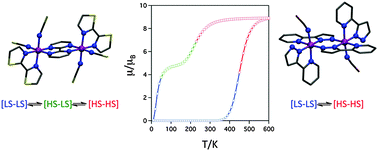
J. Mater. Chem. C, 2015,3, 7954-7961
https://doi.org/10.1039/C5TC01304F
Critical assessment of the nature and properties of Fe(II) triazole-based spin-crossover nanoparticles
Nanoparticles of the compound [Fe(Htrz)2trz]BF4 are shown to have a rod shape. Their size is found to control the width of the thermal hysteresis displayed in the spin crossover of this material, while the removal of surfactant results systematically in a reduction of the hysteresis width, by up to 16 K, both effects being original and important for potential applications.
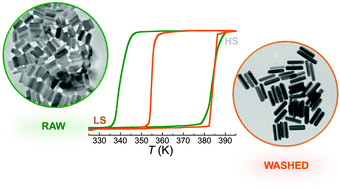
J. Mater. Chem. C, 2015,3, 7916-7924
https://doi.org/10.1039/C5TC01174D
Unravelling the chemical design of spin-crossover nanoparticles based on iron(II)–triazole coordination polymers: towards a control of the spin transition
We present a systematic study of the key synthetic parameters that control the growth of Fe–triazole spin-crossover nanoparticles and the effect of this size modulation on the spin transition.

J. Mater. Chem. C, 2015,3, 7946-7953
https://doi.org/10.1039/C5TC01093D
Modulation of the ligand-based fluorescence of 3d metal complexes upon spin state change
Complexes bearing a polyheteroaromatic fluorophore show a modulation of the fluorescence depending on the spin state of the metal centre.
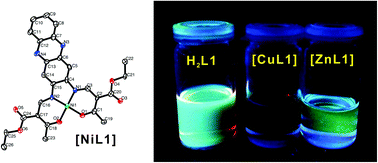
J. Mater. Chem. C, 2015,3, 7925-7935
https://doi.org/10.1039/C5TC00837A
Bimetallic MnIII–FeII hybrid complexes formed by a functionalized MnIII Anderson polyoxometalate coordinated to FeII: observation of a field-induced slow relaxation of magnetization in the MnIII centres and a photoinduced spin-crossover in the FeII centres
A 1-bpp-functionalized Anderson POM was reacted with Fe2+.
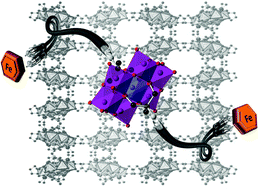
J. Mater. Chem. C, 2015,3, 7936-7945
https://doi.org/10.1039/C5TC01089F
Bead-like structures and self-assembled monolayers from 2,6-dipyrazolylpyridines and their iron(II) complexes
Drop-casting [Fe(bpp)2][BF4]2 (bpp = 2,6-di[pyrazol-1-yl]pyridine) onto HOPG affords chain-of-beads nanostructures. SAMs of bpp derivatives with sulfur-containing tethers are also described.
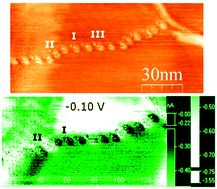
J. Mater. Chem. C, 2015,3, 7890-7896
https://doi.org/10.1039/C5TC01233C
Multiple structural transformations coupled with switchable magnetic and dielectric responses in an amphidynamic crystal of 4′-tert-butylbenzylpyridinium bis(maleonitriledithiolate)nickelate
An amphidynamic crystal shows a two-step structural transformation; the steps are coupled to both hysteretic magnetic phase transitions and dielectric anomalies.
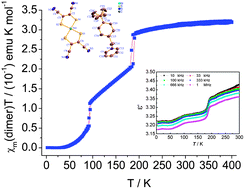
J. Mater. Chem. C, 2015,3, 7906-7915
https://doi.org/10.1039/C5TC00676G
Predictable adjustment of spin crossover temperature in solutions of iron(III) complexes functionalized with alkyl-urea tails
A new series of amphiphilic alkylurea functionalised iron(III) sal2trien complexes were prepared by substitution of phenolic ligand site with OCnH2n–NHC(![[double bond, length as m-dash]](https://www.rsc.org/images/entities/char_e001.gif) O)NHCmH2m+1 tails (n = 5, 9, m = 4, 12, 14, 16).
O)NHCmH2m+1 tails (n = 5, 9, m = 4, 12, 14, 16).
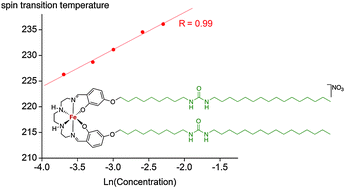
J. Mater. Chem. C, 2015,3, 7883-7889
https://doi.org/10.1039/C5TC00871A
A large spin-crossover [Fe4L4]8+ tetrahedral cage
A large iron(II) tetrahedral cage displays temperature induced spin-crossover and liesst effects.
![Graphical abstract: A large spin-crossover [Fe4L4]8+ tetrahedral cage](/en/Image/Get?imageInfo.ImageType=GA&imageInfo.ImageIdentifier.ManuscriptID=C5TC00991J&imageInfo.ImageIdentifier.Year=2015)
J. Mater. Chem. C, 2015,3, 7878-7882
https://doi.org/10.1039/C5TC00991J
Cellulose–spin crossover particle composite papers with reverse printing performance: a proof of concept
We report on a thermochromic paper with reverse printing performance.
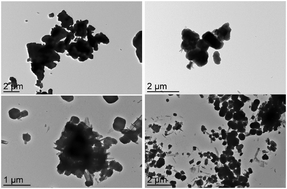
J. Mater. Chem. C, 2015,3, 7897-7905
https://doi.org/10.1039/C5TC01246E
Novel Fe(II) spin crossover complexes involving a chalcogen-bond and π-stacking interactions with a paramagnetic and nonmagnetic M(dmit)2 anion (M = Ni, Au; dmit = 4,5-dithiolato-1,3-dithiole-2-thione)
A novel Fe(II) complex with a π-radical anion exhibited a complete spin crossover transition with a stable paramagnetic state due to a strong chalcogen-bond and π-stacking interactions.
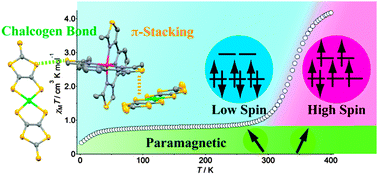
J. Mater. Chem. C, 2015,3, 7858-7864
https://doi.org/10.1039/C5TC00859J
Vacuum-evaporable spin-crossover complexes: physicochemical properties in the crystalline bulk and in thin films deposited from the gas phase
Vacuum-evaporable Fe(II) complexes exhibit greatly different spin-crossover behaviour in thin films deposited from the gas phase and the crystalline bulk.
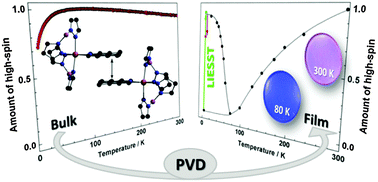
J. Mater. Chem. C, 2015,3, 7870-7877
https://doi.org/10.1039/C5TC00930H
The impact of halogen ions on the guest dependent spin crossover behaviour and porosity of Co(II) one-dimensional coordination polymers [CoX2(4′-(4-pyridyl)-2,2′:6′,2′′-terpyridine)] (X = Cl and Br)
Halogen ions in the Co(II) SCO–CPs [CoX2(pyterpy)] (X = Cl and Br) impacted on their SCO behaviour and porosity.
![Graphical abstract: The impact of halogen ions on the guest dependent spin crossover behaviour and porosity of Co(ii) one-dimensional coordination polymers [CoX2(4′-(4-pyridyl)-2,2′:6′,2′′-terpyridine)] (X = Cl and Br)](/en/Image/Get?imageInfo.ImageType=GA&imageInfo.ImageIdentifier.ManuscriptID=C5TC00864F&imageInfo.ImageIdentifier.Year=2015)
J. Mater. Chem. C, 2015,3, 7865-7869
https://doi.org/10.1039/C5TC00864F
2,2′-Dipyridylamino-based ligands with substituted alkyl chain groups and their mononuclear-M(II) spin crossover complexes
Fundamental structural, magnetic and photomagnetic properties of Fe(II) and Co(II) complexes of alkyl-chain substituted ligands are described.

J. Mater. Chem. C, 2015,3, 7845-7857
https://doi.org/10.1039/C5TC00491H
Multi-modal sensing in spin crossover compounds
We demonstrate multi-modal sensing capabilities of short chain alcohols of spin crossover compounds by integrating them into a micrometric TAG sensitive to the colour and birefringence.
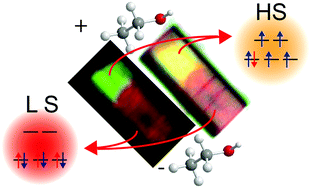
J. Mater. Chem. C, 2015,3, 7836-7844
https://doi.org/10.1039/C5TC00845J
Tunable cooperativity in a spin-crossover Hoffman-like metal–organic framework material by aromatic guests
The spin-crossover cooperativity of a Hoffman-like metal–organic framework is dramatically modulated by introducing different aromatic guest molecules (benzene, naphthalene, anthracene, and ferrocene) with the thermal hysteresis width ranging from 0 K to 73 K.
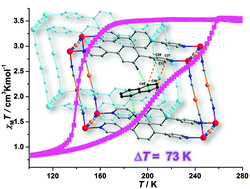
J. Mater. Chem. C, 2015,3, 7830-7835
https://doi.org/10.1039/C5TC00432B
Intermediate-paramagnetic phases with a half and a quarter spin entities in fluorinated biphenyl-3,5-diyl bis(tert-butyl nitroxides)
A ground-triplet molecule 25FBPBN showed spin-transition-like behaviour with a small hysteresis, while 3FBPBN maintained a single phase.
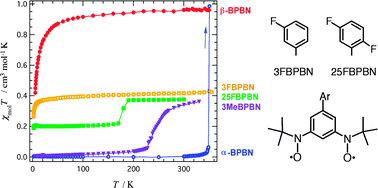
J. Mater. Chem. C, 2015,3, 7813-7818
https://doi.org/10.1039/C5TC00668F
Studies on bifunctional Fe(II)-triazole spin crossover nanoparticles: time-dependent luminescence, surface grafting and the effect of a silica shell and hydrostatic pressure on the magnetic properties
SiO2-coated Fe-triazole spin-crossover nanoparticles were functionalized with dansyl luminophores.

J. Mater. Chem. C, 2015,3, 7819-7829
https://doi.org/10.1039/C5TC00685F
Water effect on the spin-transition behavior of Fe(II) 1,2,4-triazole 1D chains embedded in pores of MCM-41
Water is crucial in exerting a confinement pressure or matrix effect on the spin transition of the SCO material in MCM-41.

J. Mater. Chem. C, 2015,3, 7802-7812
https://doi.org/10.1039/C5TC00311C
About this collection
The current drive for research into spin-crossover materials was initiated by Kahn et al, when he first demonstrated their use as bistable materials in display devices. More recently the field received another boost from the discovery that spin-state switching also functions at the nanoscale, first in nanoparticles and then in thin films.
In a drive to expand the range of applications, multifunctional materials are also being pursued that use spin-transitions to trigger other properties of a material (conductivity, fluorescence, magnetic ordering). Spin-transition centres are also being used to produce thermochromic polymers, amphiphiles, gels and liquid crystals; and, in chemically responsive framework materials.
This issue aims to highlight the recent advances of spin-state switches in all these areas of materials chemistry.